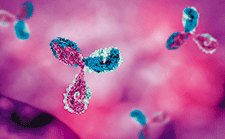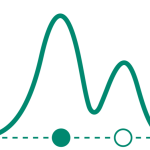
By Cynthia A. Challener
New ligands are being developed to meet the separation and purification needs of next-gen biologics.
Affinity chromatography offers the high selectivity required for biopharmaceutical manufacturing and analysis. Specific binding interactions between biologic molecules and immobilized affinity ligands allow for selective separations. With the advent of next-generation biopharmaceuticals, chromatography material suppliers have been challenged to develop affinity ligands and support systems that enable the separation and purification of not only novel protein-based biologics, but a wide range of other biomolecules, from viral vectors and nucleic acids to cells.
Beyond impurity removal for “simple” proteins
Affinity chromatography in biologics manufacturing has typically served as a method for removal of process-related impurities such as host-cell proteins and DNA, with Protein A the most widely used resin. Resin suppliers have in recent years been challenged to increase the productivity of the capture chromatography process to enable more efficient purification of increasingly high titers. They have also needed to develop resin chemistries more suitable for the growing range of protein-based biologics, such as fusion proteins and antibody fragments, and affinity ligands that can separate not just process impurities, but closely related protein products.
Protein A is the most sensitive resin to cleaning-in-place and sanitization processes, and one key issue has been the development of more robust versions that can withstand high pH washes to prevent biocontamination, according to Eva Heldin, section manager for bioprocess R&D at Cytiva. To meet this need, in 2017 the company developed a new Protein A ligand that offers both greater caustic stability (up to 1 molar sodium hydroxide) and increased binding capacity for monoclonal antibodies (mAbs). It also has the ability to bind molecules with a certain variant of the VH3 domain and thus can be used for the purification of antibody fragments and bi/multispecific antibodies.
In addition to more base-tolerant resins, the selection of Protein A-based affinity resins has expanded to include resins with increased capacity and improved homogeneity of the chromatography beads, which helps to reduce elution volumes, enabling increased process intensification and throughput, according to Michael Murray, a director of downstream process development with Fujifilm Diosynth Biotechnologies. He points to engineered antibody affinity resins and mild-pH elution Protein A resins that enable elution of mAbs without the use of traditional, low-pH elution buffers as important examples.
“As the complexity of the medicines in pipelines increases, so do the processes required to purify them, and these affinity resins allow platform-like approaches to novel molecular entities, reducing the time to manufacture biologics. The mild pH elution of these resins allows the traditional mAb purification processes to be applied to low-pH labile mAbs or proteins engineered with Protein A binding domains,” Murray notes.
The binding capacities of these new resins are, however, typically lower than state-of-the-art Protein A products. “Increasing binding capacities while retaining unique selectivity continues to be a development opportunity for resin manufacturers,” he adds. There is also a continual demand to increase the productivity for Protein A resins in order to achieve faster purification cycles and higher binding capacities, according to Heldin. She does add, however, that as knowledge increases about different affinity ligands, there is an improved opportunity to tailor future Protein A resins for specific needs regarding affinities, pH elution, and alkaline stability.
Significant effort has in fact been directed at designing different libraries of affinity ligands so that structures of choice can be retrieved based on the application, according to Mario DiPaola, senior scientific director at Charles River Laboratories. “More common synthetic chemical ligand libraries include triazine biomimetic structures, multicomponent Ugi reaction libraries, and peptoids. Libraries of ligand peptides have been used for the purification of fibrinogen and immunoglobulins. Other libraries consist of polypetides produced by means of phage display and/or ribosome display and aptamers, short single-stranded RNA or DNA oligonucleotides that spontaneously fold into structures with high affinity for protein targets,” he observes.
Thermo Fisher Scientific has taken the approach of developing product-specific affinity chromatography ligands based on its camelid VHH antibody fragment technology, according to Laurens Sierkstra, affinity purification business lead in the BioProduction Division.
“We offer products targeting other domains on antibodies that support the development of novel antibody fragments and formats for which Protein A does not work, such as those binding to the Fc region or CH1 region of antibodies. The technology has also been used to develop chromatography resins for manufacturing of non-antibody biosimilars—such as FSH [follicle-stimulating hormone] and hCG [human chorionic gonadotropin]—and viral vectors,” Sierkstra says. The technology is being used in both commercial and clinical manufacturing.
A separate area of development is the use of membrane adsorbers for capture of mAbs and other smaller biomolecules, for which limitations in capacity have previously restricted their use, according to Volkmar Thom, head of membrane modification at Sartorius. “There appears to be a renaissance occurring in this field. Several parties are working on new membrane materials and formats, aiming to overcome capacity issues, especially in affinity applications. We believe new technology developments will enable this step change, delivering high productivity in ready-to-use devices,” he says. Thom notes that while increased binding capacity is key, the importance of scalability, maintaining permeability and operating conditions suitable for manufacturing, and device design are equally critical.
Affinity chromatography for bispecific antibodies
Due to the molecular diversity of bispecific antibodies, a general purification platform is not available. A toolbox approach is needed, in which purification is based on molecular design, according to Heldin. Many process development scientists are using alternative (non-Fc) Protein A antibody-binding domains to aid purification, according to Jonathon Haigh, head of R&D for downstream processing operations with Fujifilm Diosynth Biotechnologies.
“Engineered recombinant Protein A resins with smaller bead sizes are often suitable for bispecific antibodies with Fc regions, while for bispecific molecules without Fc regions, other affinity resins can provide good options,” Heldin comments. In the latter case, protein L affinity chromatography appears to be a suitable replacement for Protein A, according to DiPaola. In addition, resins with affinity for many VH3 domain regions are often a good choice for bispecific antibody fragments, while resins with affinity for the kappa light chain may be better alternatives for other bispecific molecule designs.
Thermo Fisher has taken this approach as well, developing a portfolio of new affinity products that target different epitopes on antibody structures and are suitable for the purification of bispecifics, according to Sierkstra.
Depending on the technology used to produce bispecific antibodies, removal of product-related variants can be a challenging hurdle that needs to be addressed, according to Haigh. He does note that the use of standard and multimodal resins and high-throughput screening technologies greatly aid in defining separation techniques.
Most importantly, Heldin adds that affinity resins for bispecific molecules must provide selectivity and a toolbox for the capture step, reducing the need for costly process development. She notes, too, that for some of these affinity ligands there is still room for improvement in terms of both binding capacity and alkaline stability.
Affinity chromatography for DNA-based biologics
Methacrylate monolithic columns have been an enabling tool for developing fast and efficient separation processes for DNA-based biologics with low back pressure, high capacity, and high stability, according to DiPaola.
He points to the use of conventional, non-porous particles in amino acids–DNA affinity chromatography for the purification of super-coiled plasmid DNA (sc pDNA) as an example. “Using amino acid affinity ligands such as arginine and lysine with monolithic supports, it is possible to achieve high flow rates along with high binding capacity and productivity, resulting in a final sc pDNA product suitably pure for therapeutic applications,” he explains.
Cytiva has increased the window of operation for the separation of open-circular versus sc pDNA by improving an existing, flexible ligand based on thiophilic and hydrophobic interactions. The new ligand uses a more rigid high-flow agarose base matrix to decrease the flexibility while retaining the same selectivity.
Oligonucleotide purification has traditionally been achieved via anion exchange, hydrophobic interaction, and reversed-phase chromatography, but interest is increasing in the use of novel affinity ligands for this application, according to Sierkstra.
Affinity chromatography for cellular products
For cell purification, expanded bed chromatography has been shown to be a more favorable mode of affinity chromatography compared to packed bed chromatography, according to DiPaola. “Expanded bed chromatography is characterized by a high interparticle porosity and surface area and consequently lower shear forces,” he observes. It also provides an efficient and gentle affinity chromatography-based technique for cell separation.
Another option is the use of monolithic, convective chromatography supports, which are widely used for the purification of macromolecules such as viruses, virus-like particles, plasmid DNA, and cells. “The transport of the target molecule through these monolithic supports is based on convection, which allows quick separation of molecules of large sizes, rather than diffusion, which favors separation of small molecules,” DiPaola explains.
Affinity chromatography for viral vectors
Viral vectors are required for the production of gene therapies and the gene modification of cells used in various cell therapies. The greatest demand is for lentiviral and adeno-associated viral (AAV) vectors, with sourcing of lentiviral vectors becoming a bottleneck for gene and cell therapy manufacturing.
Traditionally, vectors have been purified using ultracentrifugation, but there has been a move toward chromatography in recent years, according to Michael Baker, a director of downstream process development at Fujifilm Diosynth Biotechnologies. “Use of affinity chromatography has removed some of the burden on the purification steps downstream of the affinity step, allowing the focus to be directed toward specific attributes such as enrichment of full capsids, rather than on removal of gross impurities from the product stream,” he says.
The interest in chromatographic solutions has led to the development of several new affinity ligands for viral vector purification. Baker points to ligands for AAV vector purification with both broad and specific serotype selectivities. “These developments have made the purification of certain vectors much more efficient and consistent than previously achievable with traditional methods,” he observes. In addition, Baker notes that manufacturers are starting to release second-generation products that are more amenable to scale up and high-throughput applications.
Affinity columns with specific antigens to each AAV serotype had been used for purification of AAV-based gene therapy products, and more recently a new resin has been introduced that binds all AAV serotypes with enhanced capacity, according to DiPaola. A new affinity purification procedure using cell surface heparan sulfate proteoglycan and the non-ionic gradient medium iodixanol has also resulted in improved viral infectivity, efficient purification of AAV vectors. Lentiviral vectors have also been purified using heparin/heparin sulfate affinity chromatography and immobilized metal affinity chromatography (IMAC), according to DiPaola.
“Following the successful development of resins enabling the scale-up of AAV production for commercial supply, Thermo Fisher has now set its sights on developing similar products for purification of adeno and lentiviruses to be offered as off-the-shelf products,” notes Sierkstra. Similar to its improvement of an affinity resin for DNA, Cytiva has improved an existing affinity resin for AAV vectors by using a much more rigid, high-flow agarose base matrix to increase the window of operation for vector purification, according to Heldin.
Affinity chromatography is also being used for the analysis of viral vectors, according to Thom. Specially designed kits specific for lenti- or adeno-virus count total viral particle load in rapid, no-wash assays.
Affinity chromatography for viruses
Membrane adsorbers with large pores and a fast, convective mode of operation have been a preferred tool for the purification of large biomolecules such as viruses, according to Thom. A new, sulfated cellulose affinity membrane specifically designed by Sartorius for virus capture provides maximum virus access with increased selectivity and product recovery. It is useful for the capture of several virus types including influenza, Japanese encephalitis, measles, and viral antigens from Hepatitis B.
“This sulfated cellulose membrane adsorber exhibits 10–20 times higher binding capacity for various strains of Influenza virus than commercially available resins, while offering comparable recovery and purity,” Thom asserts. In a pandemic situation, he notes that production of 40 million doses of flu vaccine is possible in one day with 54 L of membrane.
Nanofibers for affinity chromatography
A number of different technologies are being explored as supports for affinity chromatography in biomanufacturing. One that is receiving significant attention is the use of nanofibers within membrane systems. Membranes based on nanofibers are interesting and could have advantages in processing, but the technology is still being developed and a successful prototype that matches resin chromatography hasn’t been demonstrated yet, according to Sierkstra.
The recent acquisitions of Natrix Separations and Puridify by MilliporeSigma and Cytiva, respectively, show that the industry is looking at alternatives to traditional chromatographic methods, according to Baker. “Both of these firms have great potential to achieve the higher flow rates of membrane technology, but with the ligand density and binding capacity of a traditional resin. In addition, when combined with their microporous structures, these technologies could represent a significant improvement over the current offerings for viral vector purification,” he says.
Cytiva is commercializing a fiber-based chromatography platform that it obtained via the acquisition of Puridify, a UK-based bioprocessing company, in 2017. The fiber format has an open pore structure that allows for convective mass transport, leading to flow rate-independent binding capacities and cycle times of minutes compared to hours for traditional resin chromatography, according to Heldin. “The technology opens new opportunities, where protein A fibers can be used for rapid cycling many times across a single batch in a repetitive manner before disposal, enabling use of the protein A capture format for mAbs to its full extent,” she asserts. The larger surface area may also make the fiber technology suitable for the purification of viral vectors.
The new resin will be produced at Cytiva’s biotechnology manufacturing center at the Stevenage Bioscience Catalyst (SBC) Open Innovation Campus, in Stevenage, UK, which was opened in November 2018.





